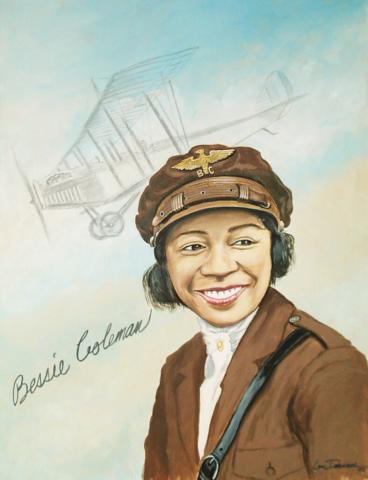Bessie Coleman was the first African-American to hold an international pilot's license and the first African-American female pilot. To make that happen, she had to study aviation in France.
Growing up in Texas, Bessie Coleman wanted to make her life matter. She often told her friends and family - then and later - that she wanted her actions to count for something.
It was hard for Bessie, though. The tenth of thirteenth children, she knew there weren't many opportunities for African-Americans in the Jim-Crow South. There were so few job options, in fact, that Bessie's father - part black and part Cherokee - decided he could do better by moving to Oklahoma (which was formerly known as "Indian Territory").
After her father left the family, life became even harder for Bessie. She thought a move to Chicago, where two of her brothers lived, would open more doors for a young African-American woman. What she learned - and whom she met - changed her life.
Young men returning to America, after fighting in Europe during World War I, talked about their experiences. Bessie read news articles which, among other things, profiled young pilots who had flown in the war. Bessie was intrigued and decided to become a pilot.
Actualizing her dream of flying, however, was not possible in the United States. Flight schools routinely turned-away women and people of color.
Robert Abbott, founder of a Chicago newspaper called the Chicago Defender, helped Bessie research where she could study outside the United States. France seemed to offer the best possibilities, but Bessie could not speak French. Before she could attend flight school, she would have to attend language school.
By the fall of 1920, Bessie was ready to book passage on a ship - the Imparator - to France. With her passport in hand, she was ready for a completely new life adventure.
Aboard ship, she was surprised - and pleased - to see there were no segregated places for African-Americans. Arriving in France, she was surprised - and discouraged - to learn that her chosen aviation school would not admit her. Two other students, both women, had crashed their planes and died. School administrators had come to believe that females shouldn't be pilots.
Using her limited French-language skills, Bessie had to find another school. She was admitted to - and graduated from - one of the best flying schools in France, which was located in Le Crotoy. She was the only African-American living in the area.
By 1921, Bessie was a licensed pilot. At the age of 29, she was the first black woman in the world to achieve that milestone. Planes had open cockpits, at the time Coleman flew, and they were notoriously dangerous.
After she returned to the States, Bessie's prowess as a pilot allowed her to fly in exhibitions. She wanted to earn enough money to open an aviation school which would admit females and people of color. Traveling the country, performing as a stunt pilot, Coleman encouraged young African-Americans to think about an aviation career.
On the 30th of April, 1926, Coleman and her mechanic were testing a new plane - in Jacksonville, Florida - for a show to take place the next day. The mechanic mistakenly forgot his wrench, leaving it unsecured in the plane.
In the air, the plane could not pull out of an intentional nose dive - reportedly because the wrench was jamming the controls. As the plane fell to earth, Bessie was thrown from her seat. (See Bessie Coleman, by Philip S. Hart, pages 95-97.)
Because of her death in the plane crash, Bessie was unable to establish the aviation school she had longed to create for African-Americans who wanted to fly. ("The air," said Bessie," is the only place free from prejudices.") Her vision and fortitude, however, inspired other black pilots to follow in her footsteps (and to study sophisticated subjects like aeronautical engineering).
It was because of Bessie Coleman that Lt. William J. Powell wrote: "We have overcome the barriers within ourselves and dared to dream." By 1942, African-Americans didn't just dream about flying - they were flying. Other forces were against them, however, preventing blacks from becoming military pilots.
Even though World War II was raging - and more and more American pilots were needed to fly bombers and fighters - blacks were prevented from participating. A significant basis for this prejudice stemmed from a 1925 report, from the War College, which states that African-Americans are incapable of performing the toughest tasks.


 Back
Back
 Next Chapter
Next Chapter

 Back
Back
 Next Chapter
Next Chapter



